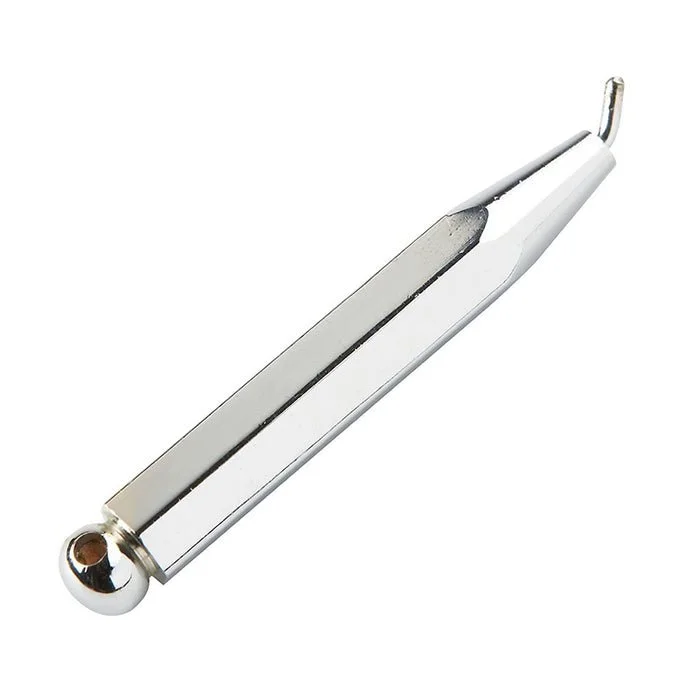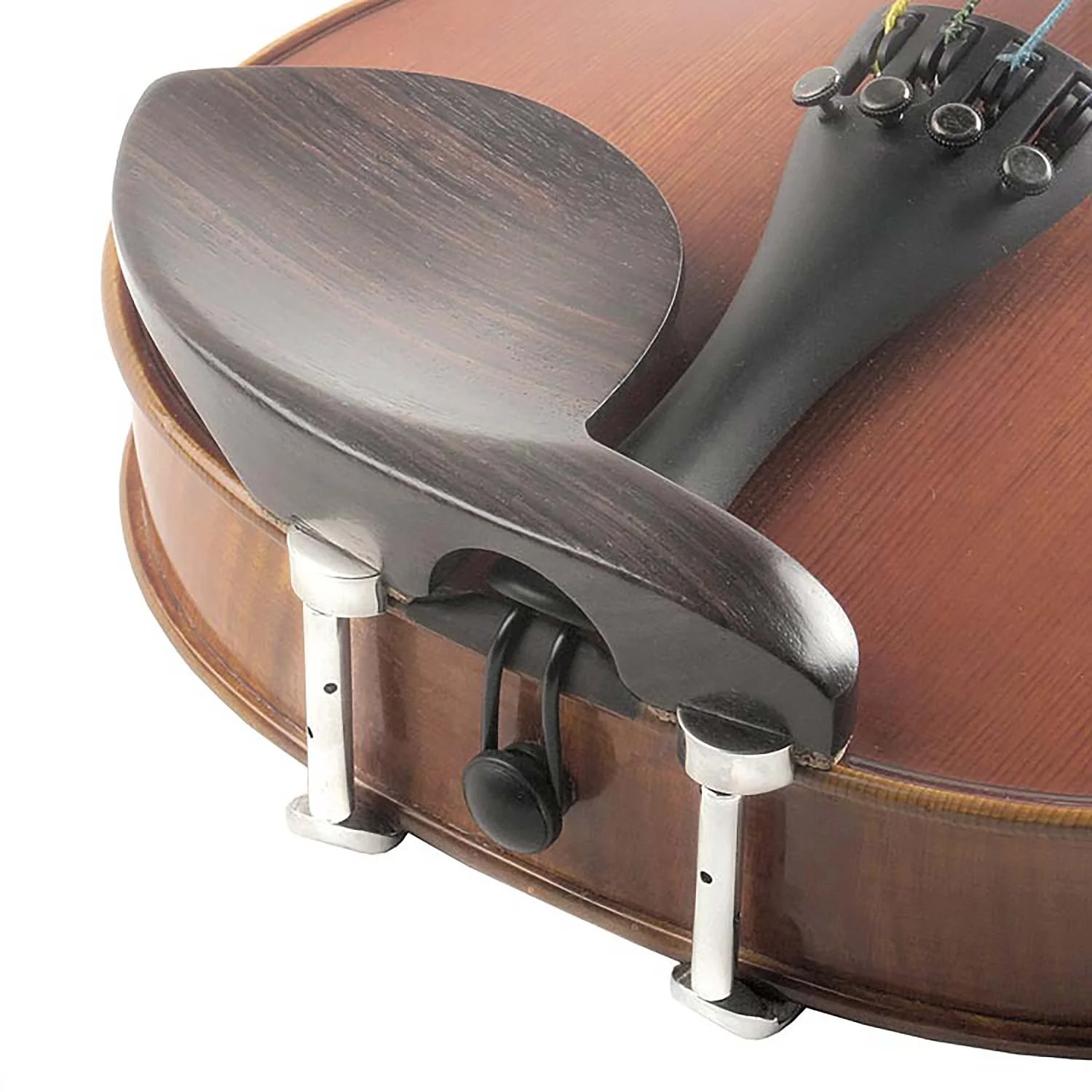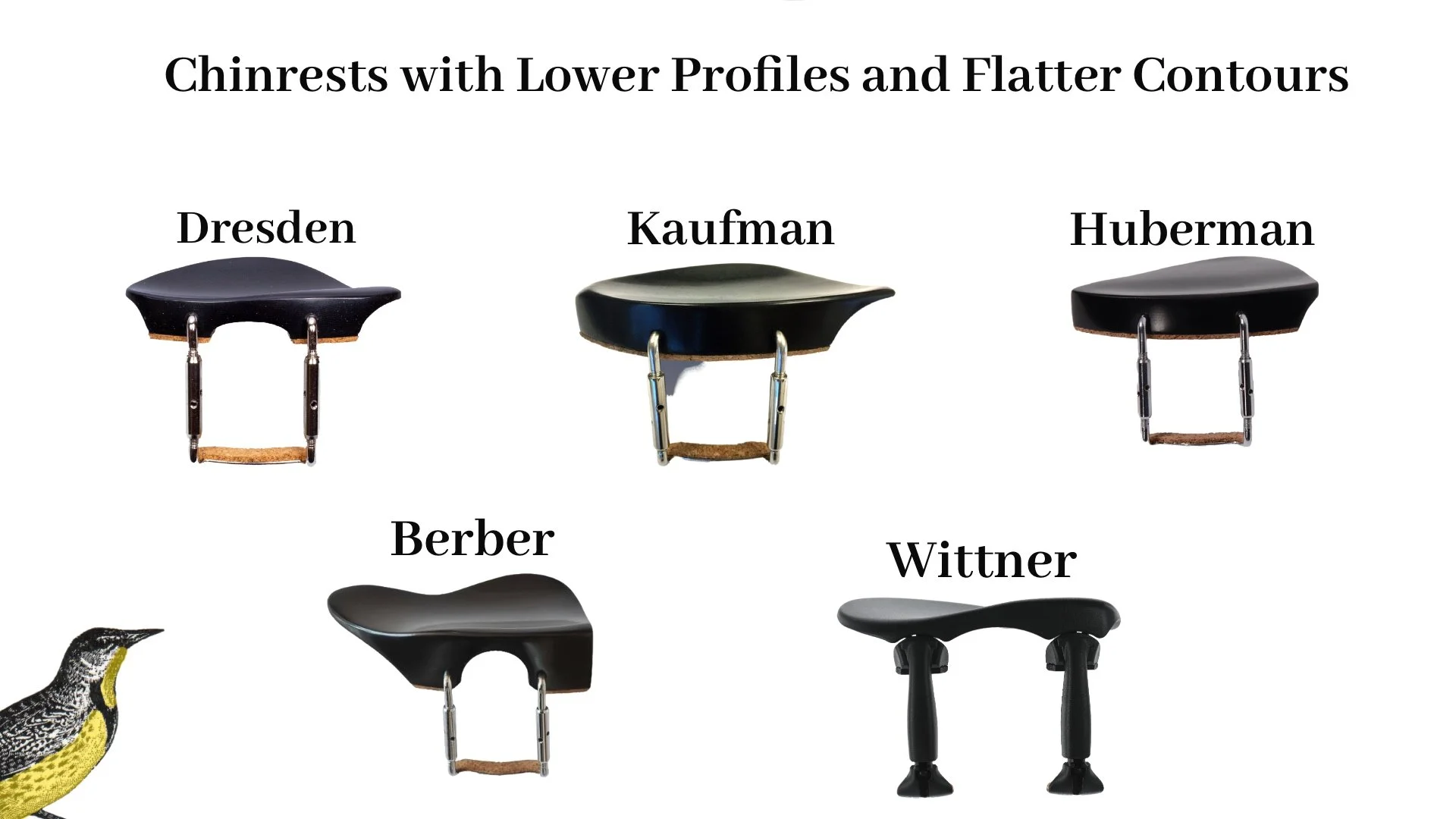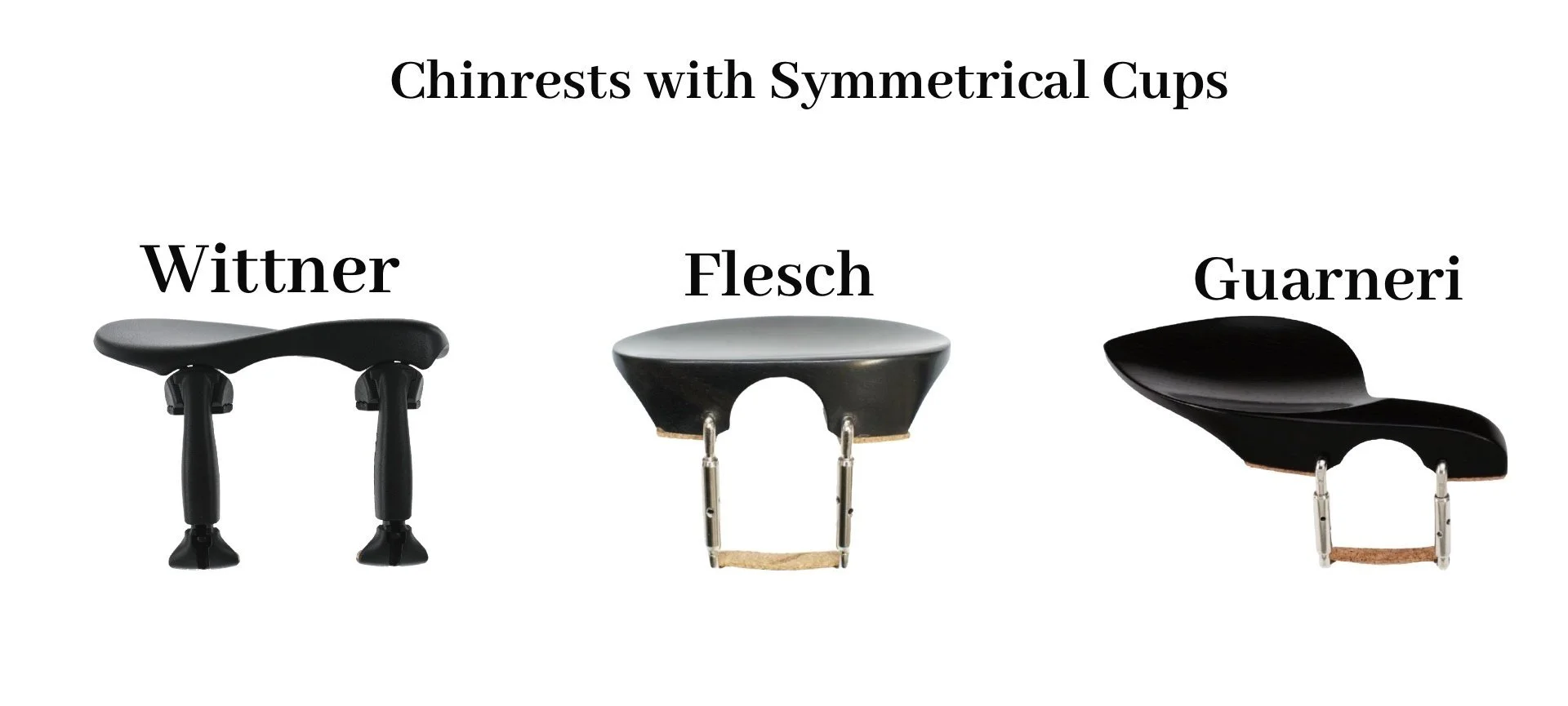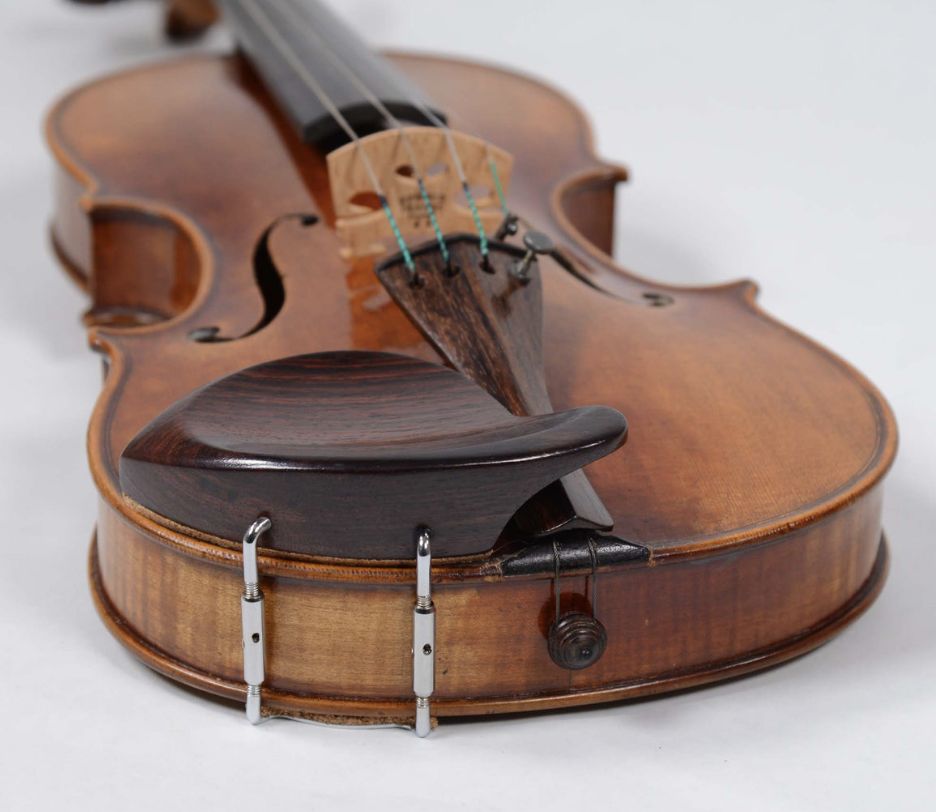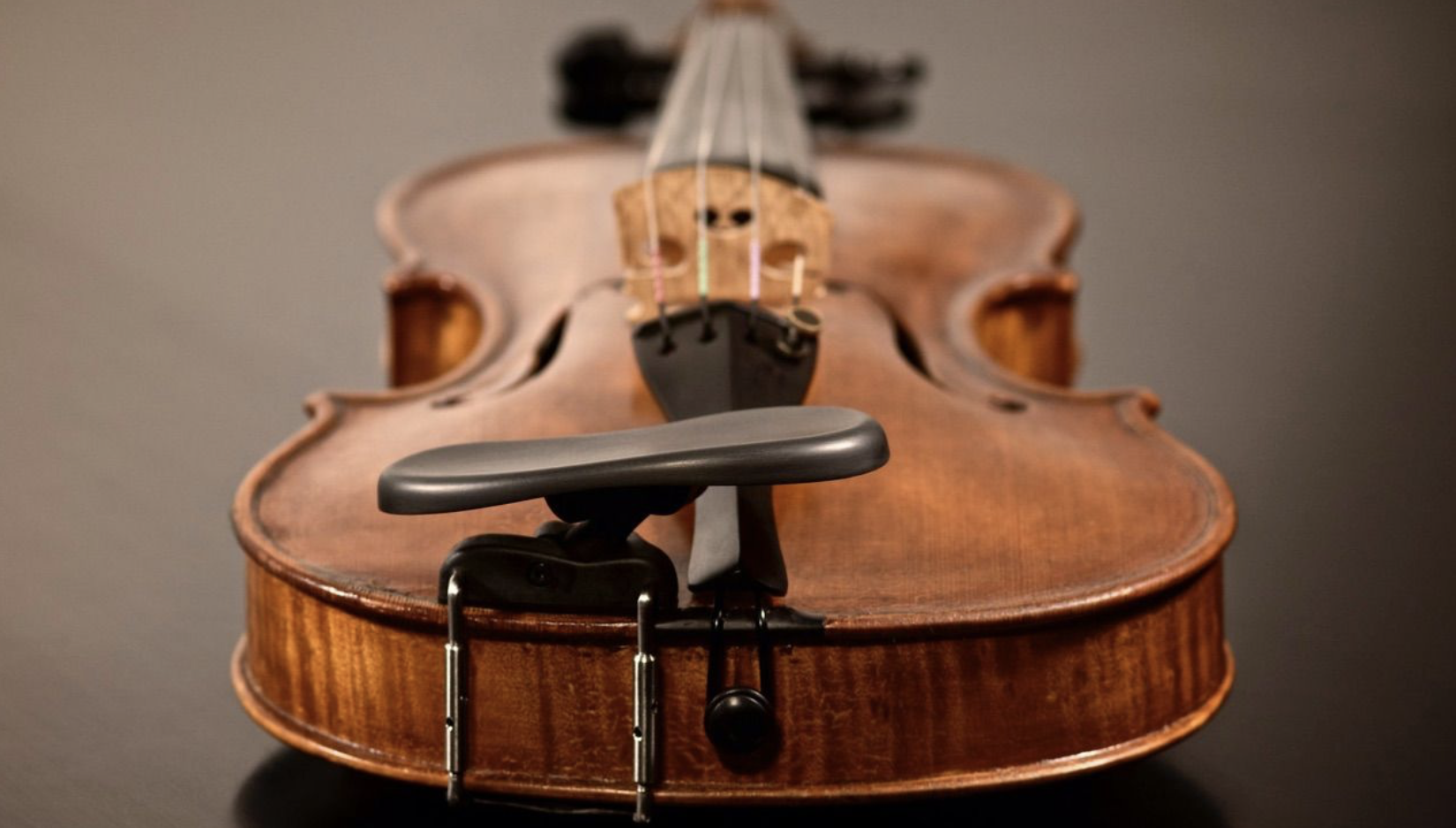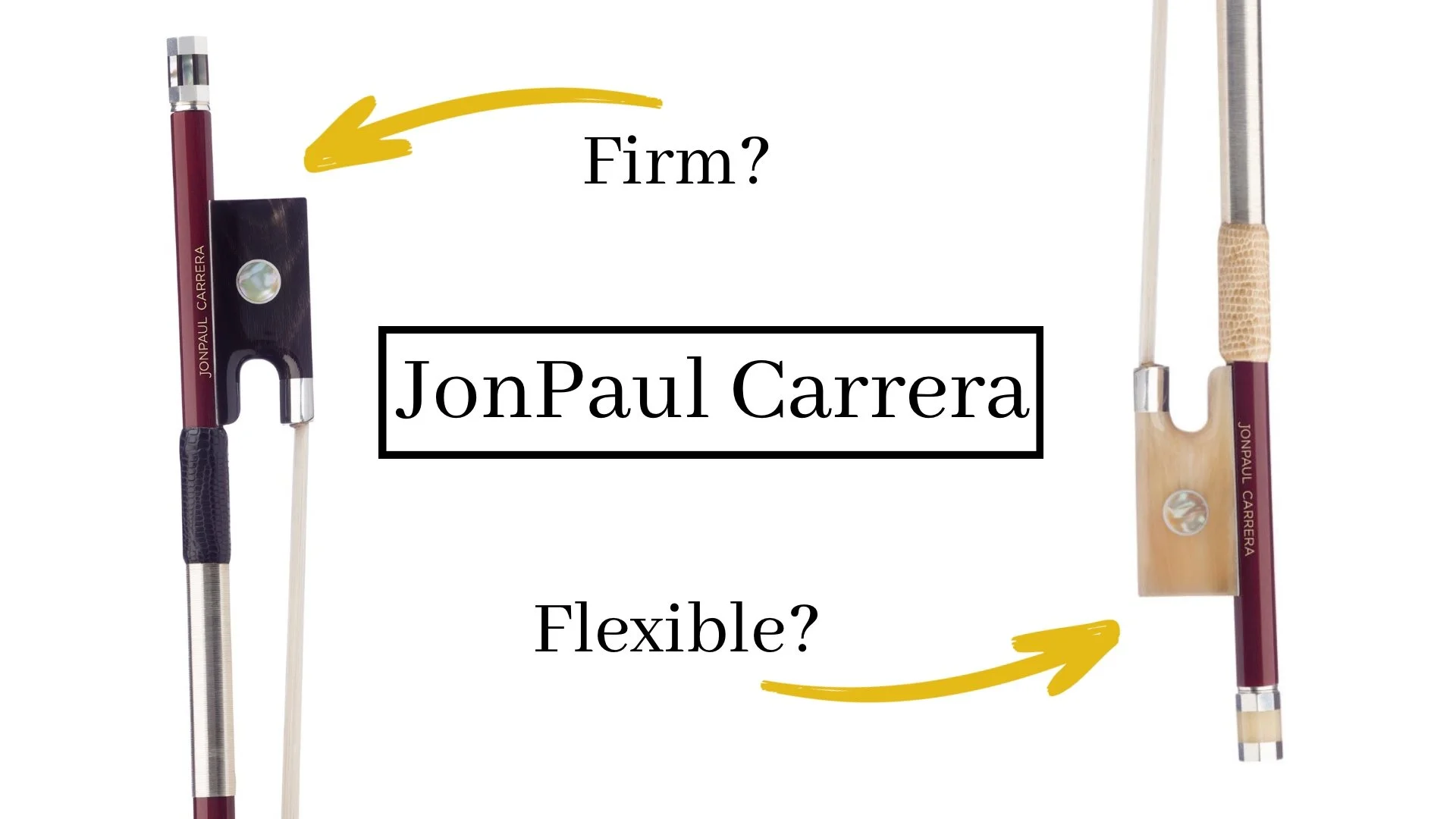Choosing the Right Chinrest: A Violin Teacher’s Ultimate Guide to Finding the Perfect Chinrest
/Being able to play violin comfortably is a crucial factor to your progress and enjoyment of playing in general. The violin chinrest plays a big part in your level of comfort, but choosing the ideal chinrest can be quite overwhelming.
There are seemingly endless varieties of chinrests and unless you are able to visit a shop that has a wide selection of chinrests in stock, it’s hard, if not impossible to know which chinrest would work for you.
Just like shoulder rests, choosing the right chinrest is a very personal choice. What works great for someone might feel terrible for you. There’s definitely some trial and error involved when choosing a chinrest, but this guide can help give you some ideas about what might work for you.
Let’s talk about a few basics before we dive into the intricacies of choosing a new chinrest.
Terminology and Chinrest Materials
First off, it is chinrest not chin rest. I know, your auto correct won’t like it and I apologize if you find a few “chin rests” sprinkled throughout this article. I tried to catch all of those little free radicals, but I’m sure a few slipped through.
And while it technically is a chinrest, it’s really where your jaw goes, not necessarily your chin, but I generally use these terms interchangeably.
There are a few important terms I’ll be using. Chinrests usually have a hallow space where the jaw rests. I call this the “cup” or the “dip.” The tailpiece on the violin is important to know since chinrest placement is either to the left or centered over the tailpiece.
Last of all, chinrests come in many types of materials: ebony, rosewood, boxwood, plastic. What ever style you eventually choose, you usually want it to match your other hardware. So if your tailpiece and pegs are black ebony, you want an ebony chinrest to match.
Can I Change My Own Chinrest?
Tool for changing the Chinrest
Absolutely! When it comes to violin maintenance and upgrades, this is one of the easiest changes to make.
Chinrests have little holes on the mounting hardware clamps. Your new chinrest may or may not come with a small wire tool to help you change the chinrest. You can purchase an actual chinrest tool, or if you have a small screwdriver set, or even a paperclip, this can work too.
How to Change the Violin Chinrest
Simply insert the tool or small screwdriver and turn to the left to loosen the two cylindrical clamps until your old chinrest is loose enough to slide off. While you have your chinrest off, I often find this is a good time to clean off any dust or rosin that’s been hiding under your chinrest!
Next, place your new chinrest on your violin, insert the tool into the holes and turn right to tighten. Tighten until the chinrest is snug. You don’t won’t the chinrest to vibrate as this will cause buzzing sounds, so make sure it is snug enough so that it isn’t moving. You can make adjustments as necessary.
Now let’s talk about how to choose the right chinrest for you. First let’s talk about the two main types of chinrests.
Types of Chinrests
While there are several types of mounting clamps, there are really two types of mounts: center mounts and side mounts.
For center mounts there is a little hole in the bottom of the chinrest where the tailpiece goes, allowing you to mount the chinrest over the center of the violin. While the chinrest may be center mounted, this does not necessarily mean the place where you put your jaw is centered over the tailpiece. With center mounts your chinrest has only one place it can be mounted: directly over the tailpiece.
Side mounts are secured to the left of the tailpiece. You have a few more options with side-mounted chinrests because you can mount the chinrest in various places along the left edge of the violin to match where your jaw would be placed.
*Note: The placement of the chinrest can affect the sound. While this is an important factor, if you are just trying to find a comfortable fit, focus first on figuring out what style works for you. Then you can experiment a little more with chinrest placement (if you have a side mount) or visit a luthier and have them make some adjustments for the best possible sound.
Next, let’s talk about three variables of chinrests: violin position, height, and contour.
Chinrests and Violin Position
Your chinrest determines where you will place your jaw, which will in turn determine the violin’s position on your shoulder.
Try this experiment. Place all four fingers on the G string and then position your jaw to the right of the tailpiece (where there is no chinrest). This places the violin much higher on your shoulder. Note how your left hand fingers, arm, and shoulder feel. Now move your jaw to the center over the tailpiece. Evaluate your fingers, arm, and shoulder again. Last of all, move your jaw to the left of the tailpiece (this may or may not be where your chinrest already is). Evaluate the left hand, arm, and shoulder again. Try this in different variations, with and without a shoulder rest, turning your head to the left and looking straight forward, or with your left hand on different strings.
Do you see how changing where your jaw contacts the violin makes a big difference in violin position?
If your jaw is to the left of the tailpiece, the violin will be slightly slower on the chest, which can be helpful for people with shorter arms. If your jaw is more over the tailpiece, the violin will be higher on your shoulder, which might be better for people with longer arms. With your jaw to the right of the tailpiece, it probably feels pretty uncomfortable! But that’s a feeling you want to understand so you know how to correct it!
As you consider the variable of violin position and how that might affect you, it’s worth discussing some common chinrests and why they don’t work for a lot of people.
What’s wrong with standard chinrests that come with most violins?
The Guarneri Problems
The most common chinrest that comes standard on most violins is the Guarneri style chinrest. It’s probably common because it’s relatively low and has quite a bit of real estate over both the tailpiece and the cup part, allowing for both a jaw position to the left of the tailpiece and over the tailpiece. But just because it has a couple different possibilities for jaw placement doesn’t mean any of them are very comfortable. In fact, I find this chinrest pretty uncomfortable for most people. Why?
Since this is a center mounted chinrest, you can’t adjust where that cup is, and often it’s not going to match the shape of your jaw. You can try to place your jaw lower, but the rigid bump over the tailpiece can feel pretty uncomfortable under the chin.
If you want to place your chin to the left of the tailpiece, a side-mounted tailpiece will give you more options for placement. And if you want to place your chin lower over the tailpiece, a chinrest with the cup area closer to the tailpiece will be more comfortable.
After teaching hundreds of lessons and helping countless students find the right setup, I’ve found that many people prefer to place their chin lower than what the Guarneri allows.
If you have this type of chinrest, and you’re not sure if this is your problem, try this. Place your jaw lower, more over the tailpiece. For now, ignore how uncomfortable that wooden bump may feel under your jaw. (If it helps, place a towel over the bump in the tailpiece). Just focus on the placement of the violin on your shoulder and how it feels to play with your chin lower.
Chinrests and Neck Height
You don’t want to have to bend your neck down or crane your neck up to reach your chinrest. Ideally, all you have to do is turn your head slightly and rest your jaw right on your chinrest. But the violin can’t magically float there at perfect height. The problem is solved through both the shoulder rest and chinrest.
By extending the feet of your shoulder rest, you can bring the violin up closer to your face. It’s perfectly fine to extend the feet to customize your shoulder rest, but eventually as the violin gets further and further away from your shoulder, you introduce some other problems.
How Violin Height Affects the Left Hand
As the violin moves away from your shoulder, it will cause your left hand and arm to move up to reach the violin. While you may not be able to tell a difference on the E or A strings, it becomes more obvious on the G and D strings and with 4th fingers. If the violin is far away from your shoulder (due to a very extended shoulder rest), it makes it harder for your elbow to pivot forward to allow your hand to reach the G string and the 4th fingers on the D and G string. This problem just becomes more exacerbated if you have shorter arms.
I experienced this phenomenon myself recently. I bought a new violin with a different chin rest than I was used to. I had my shoulder rest adjusted fairly high to compensate for the lower than normal chinrest. I was fairly comfortable, but as I would play, I would persistently have trouble with my pinky on the G and D strings. I have pretty short hands so pinky stretches have always been an issue for me. I didn’t think anything of it, other than the fact that I probably need to work on my pinky intonation. Eventually I thought, “My fourth finger just sounds awful on the G string. I don’t ever recall being so disgusted with my little pinky.” Then I started investigating. I brought the shoulder rest down about a half of an inch and voila! It was instantly easier to reach the pinky which allowed me to play it more in tune.
The lesson is, a little bit of height in one way or the other can play a big role in your left hand technique.
So you want to keep the shoulder rest as close to your shoulder as possible, but if you have an average or longer neck, this will force you to bend your neck down to reach the violin, which is very uncomfortable. That’s where a taller chinrest comes in!
A taller chinrest can allow you to keep the violin closer to your shoulder, but places the chinrest right under your jaw. A perfect combination!
Many, but not all chinrests styles will come in extended versions. For instance, you can get a Guarneri in various heights. Although some models allow for taller heights than others. Height is measured in millimeters.
Keep in mind, you don’t have to have a very tall neck to still deal with these sorts of issues. I would say my neck is average height, but it’s an issue that’s taken a lot of trial and error for me to understand.
If you are always feeling like your neck is bending down to reach the violin, or if you have a very tall shoulder rest, a taller chinrest could be the answer to your problems.
Chinrests and Contour and Shape
Contour is a wild variable. You’ll see all sorts of shapes and bends and curves out there. Which one is right for you? Some chinrests have a very definitive cup where you jaw is placed, others are less defined. Some have a very obvious lip on the edge, some have barely any lip at all.
If the cup is less defined, you may have a little more freedom with where exactly to put your jaw. A more defined edge can help you feel like the chinrest is secure under your jaw, but it may also feel uncomfortable and sharp under your chin. A more rounded edge or no edge at all may feel smoother and less awkward.
I’m going to simplify contours into three main shapes. Flatter contours, symmetrical contours, and countours with a rise and a dip.
Chinrests with flatter contours include: Dresden, Kaufman, Huberman, Wittner, and the Berber. The Berber looks pretty wavy, but the edge is relatively flatter. These chinrests with lower profiles can be great for people with shorter necks. If you constantly feel like something is jabbing and poking you, you may want to try a flatter contour, or look for a softer rise, or look for a chinrest with a softer edge, like these chinrests.
Chinrests with symmetrical cups includes Flesch, Wittner, or Guarneri to name a few. Players who are more forward-looking when they play usually like these types of chinrests.
When it comes to contours with a rise, you’ll often see a dip on the left side of the chinrest followed by a slight rise to the right over the tailpiece. The amount of rise will vary as will the sharpness of softness of the rise.
This contour can affect the tilt of your head. The dip on the left side can allow your jaw to “escape” while the rise towards the tailpiece gives your chin a place to rest. Some people like this, some people don’t!
Chinrests with an asymmetrical dip and rise include Tekka, Stuber, and Hamburg. Players who are more left-looking when they play may like these.
Why is your current chinrest uncomfortable?
Now that you know a little bit about chinrests variables, I want you to determine what current chinrest you have, and why it’s not comfortable.
The more you know about your current chinrest and what specifically makes it uncomfortable, the easier it will be to choose a chinrest that will be a better fit.
Here are some things to consider when trying to determine why the chinrest is uncomfortable.
Does the shape of the chinrest force you to hold your jaw or face in an uncomfortable position?
Is the head tilted uncomfortably, turned, or thrust forward?
Is the jaw free to balance the violin and move, or is it stuck in one place and one position?
Do you feel a certain part of the chinrest jabbing into your neck or jaw?
Does it feel like the contour of the chinrest does not match the contour of your jaw?
Do you have to bend your head down to place your jaw on the chinrest? Do you have to reach up with your neck to place your jaw on the chinrest?
Does the violin feel heavy? (The further away the violin is from your neck, the heavier it will feel.)
My Chinrest Recommendations
Before I recommend some chinrests, I need to give a caveat again. Everyone’s body type is different and therefore everyone’s chinrest preferences will be different as well. Just because I use and enjoy some types of chinrests, does not mean that’s what you should go buy! Use these resources and suggestions as a basis for further research and trial and error!
It’s also worth noting that there are certain styles of chinrests and but many makers and variations on these styles. For instance, there is no one company that makes Guarneris. So you’ll find slight variations in contour and height across these styles depending on the maker and who you buy from, so shop around to see all varieties.
1. Center Chinrest with a Centered Cup
Why it’s different: These styles of chinrests have a cup that is centered over your tailpiece, allowing you to place your jaw right on the centerline of the violin. Most center chinrests have a fairly well defined cup and lip, but are fairly uniform and flatter without a sharp rise.
Why it might be for you: If you’ve found you like to hold the violin with your chin placed a little lower, this might be a great option. The defined lip hooks securely under your jaw and the flatter shape won’t feel like something is jabbing awkwardly into your jaw.
Why it might NOT be for you: This will place the violin higher on your shoulder, which may be a problem if you have very short arms. If you’re used to holding the violin higher to the left of the tailpiece (with a Guarneri or other side mount) this chinrest might feel like a big change. Keep reading for some other options that split the difference.
Center chinrests come in various styles by various makers. If you’re interested in a fully centered chinrest, look at Flesch, Wittner Augsburg, or Berber.
2. Stuber Chinrest
Why it’s different: The Stuber is a side mount positioned to the left of the tailpiece, but it has a gentle rise that continues over the tailpiece. It’s got a smooth, rounded edge. It general, everything is very smooth allowing for a comfortable fit without anything jabbing into your jaw. But there’s also a lot of real estate to the left of the tailpiece, so you’ve got lots of comfy options. You can place your jaw higher or closer to the tailpiece, so it’s a good mix between a Guarneri and a Center chinrest.
I used a Stuber chinrest for years and absolutely loved it. I only moved on when I realized I need a chinrest with more height and Stuber models didn’t come in extended versions.
Why it might be a good fit for you. If you want smooth contours, but a little bit of a rise for your chin to rest, Stuber might be a good fit for you.
Why it might NOT be good for you. If you need more or less height, keep reading for more options.
The Hamburg is a similar style chinrest worth investigating as well.
3. Teka Chinrest
Why it’s different: The Teka has a similar shape to the Stuber. It’s a side mount and there’s a slight dip on the left followed by a rise over the tailpiece. The Teka’s edges are a little more defined than the rounder Stuber, which may feel more pronounced under the jaw. But what the Teka has in abundance is height. This model also comes in Extra Tall with various heights of 30 mm, 40 mm, and 50 mm! For reference, I currently use a 30 mm Teka.
Why it might be a good fit for you: If you need height, this model has it!
Why it might NOT be a good fit for you: The more defined edges can be a bit sharp under the jaw. If you have a bony chin, or if your neck is shorter, keep reading!
4. Dresden/Kaufman/Huberman Chinrests
Why they’re different: The Dresden, Kaufman, and Huberman are three similar types of side-mounted chinrests. They have a fairly low profile without a lot of lip, contour, or edge. While some of them are fairly small, you can find versions with a little more real estate for bigger jaws. There seems to be a lot of variation with height with these styles, so shop around to find the height that works for you.
Why it might be a good fit for you: If you have a shorter neck and always feel like something is jabbing into your neck and jaw, these options might be a good fit.
Why it might NOT be a good fit for you: If you need more more contour, the previous chinrests will be better options.
5. Adjustable Chinrests
With all of these options, you may be thinking, “I wish I could customize my own chinrest.” Well you can. There are a few customizable chinrests options.
Wittner
Wittner chinrests are made in Germany. They’re plastic, hypo-allergenic, and come in both center and side mount options. Their molded plastic cups are smooth, comfortable, and light. Augsburg and Zuerich models are both height and tilt adjustable.
The kréddle
The kréddle is well, everything. Literally every angle is adjustable. You can get center or side mounted options and it can be adjusted to various heights and pretty much any contour. Some people call it “infinitely adjustable.” It’s not cheap, but if you’re of the “buy once cry once” mindset and would rather pay for one chinrest that does it all as opposed to 3 or 4 chinrests that aren’t quite right, this might be for you. I have some students that love it. Others find it a little overwhelming.
Why adjustable chinrests might be a good fit for you: If you have a taller neck, these adjustable chinrests can help you find the perfect height. These are also great if you love experimenting and want to understand exactly what your jaw shape needs. However, all of those options have a downside…
Why adjustable chinrests might NOT be for you: Some people find all of the customizable options overwhelming. If you just want a “plug and play” option that you can stick on your violin and be done with it, then opt for a more traditional chinrest.
Worthy Mentions
It’s also worth noting a few special chinrest companies.
The WAVE
The WAVE is a chinrest company that produces some slightly unusual, yet beautiful looking chinrests. I think one of their lines from their website describes what’s different about this style of chinrest. “What if instead of forcing the chin over to reach the chinrest, the chinrest came back to meet the chin?” They offer two models of chinrests in various heights. What’s great about ordering is that they will send you four models to try out for 30 days. Send them all back if you’re not happy, or keep the one you love!
Frisch and Denig
If you’re tired of doing all the research and buying lots of chinrests, and you just want someone to tell you exactly what you need, then Frisch and Denig offer a truly personal approach to chinrest fitting. You can arrange a fitting at their store or find someone near you who does chinrest fitting. Then they create a custom chinrest just for you!
===>Visit Frisch and Denig’s website
Cushions, Covers, and Towels
There are lots of accessories you can purchase to make your chinrest more comfortable. Cushions like the Impressionist form-fit to your jaw for a custom padding. Be aware when you are adding cushions. This adds height to your chinrest. If you need height or you need to lower your shoulder rest anyway, great! If you’re already reaching up an over to get to your chinrest, you’re going to have to reduce your shoulder rest height or get a lower chinrest so you don’t overreach your neck with the new cushion.
Chinrest covers can soften all of those hard edges without adding a lot of height. And if you find the mounting hardware or clamps irritating against your neck, you can purchase covers just to cover the metal clamp area.
A simple small towel or handkerchief placed between your neck and the chinrest can also do wonders when it comes to reducing marks left on your skin from the chinrest, or any other irritation.
Click on each image to browse chinrest cushions and covers.
Final Thoughts on Choosing the “Perfect” Chinrest
Finding the perfect chinrest is no easy task. It can be overwhelming and sometimes downright frustrating. But the process of choosing the right chinrest is also a process of discovery as you learn more about your own body type and its specific needs. That special understanding of your body can help you immensely when it comes to playing. So even failed chinrests are not complete failures if you learned something about yourself!
I’ll leave you with some final thoughts about trying to find that absolute perfect setup with your shoulder rest and chinrest. It’s a very worth endeavor to keep at it until you find something that’s comfortable for you. But keep in mind that even professionals are always experimenting and learning and tweaking our setups. It’s a gradual process, so don’t be upset if you don’t get it on the first try.
But you also don’t want the search for the perfect setup to completely dominate your practicing and rob your joy of playing. While you can find something that works for you, a perfect, totally tension-free setup might not really exist. There are moments and times in our life when playing violin is just not the most comfortable thing in the world. And if you’re a beginner, it’s all going to feel awkward for a while. Be aware of your body and places of tension, but don’t focus on it 100% of the time. Remember to take some time to just enjoy playing the music you love!
Happy Practicing!




